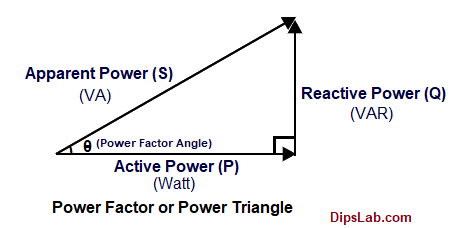
Here, I am describing an electric power and its types which are useful everywhere in electrical technology. When we study, the first arises
- What is Electric Power?
- What are the types of Electric Power?
Let’s study more about electric power in detail.
What is Electric Power?
The basic definition of Power is ‘the rate of doing work’. It means, work has consumed energy with respect to a particular time.
Definition: Based on the technical term-
The rate of electrical energy which consumed in an electrical circuit is called as Electrical Energy.
And
The rate of electrical energy which converted into the another form of energy is called as Electrical Energy.
In the electrical circuit, power consumes through connecting load or device. And it converts into another form like light energy, heat energy, motion energy.
For Example, Electrical bulb ( power in watt) converted electrical energy into light and heat energy.
Formula:
Calculating the electric power by using different formula –
Electric Power (P)= (Work/Time)= (Energy/Time)
Electric Power (P)= (Voltage*Current)= [(Voltage)²/Resistance]= (Current)²*Resistance]
According to the formula, electric power is product of the electric current and voltage.
You can be calculated the electric power by using the online electrical tool.
[CP_CALCULATED_FIELDS id=”10″]
[CP_CALCULATED_FIELDS id=”11″]
[CP_CALCULATED_FIELDS id=”12″]
The SI unit of the electric power is Watt (W) or Joule per sec (j/s) or Volt-ampere (VI).
Power can be measured in the watt (W), kilowatt (kW) or megawatt (MW) by the energy meter or wattmeter.
Read More: Difference between the Electric Power and Energy.
What are the types of Electric Power?
In the electrical and electronic systems, electric power is classified into two main categories.
This classification of electric power depends upon the nature of the flowing electric current (I) and voltage (V) source.
- AC Electric Power
- DC Electric Power
Let’s see each type in detail.
Note: You can learn here difference between the alternating current and direct current
1. AC Electric Power
A definition of electric power is
The rate of flows of electrical energy in sinusoidal nature through an electrical circuit.
AC power is mostly used because it can easy to power step up and step down by using the Electrical Transformer. The main function of the transformer helps to regulate current and voltage at a constant frequency.
In the electrical circuit, this AC power is consumed by the connecting load to the circuit. It consumes in the resistive load, inductive load and capacitive load.
According to the nature of connecting load in the electrical circuit, AC power is classified into three parts.
- Active Power
- Reactive Power
- Apparent Power
Mostly, in an electrical power system, these three AC source power is used. So, the power system usually works on a single-phase and three-phase AC power System.
Active Power (P)
Active power called as ‘Real Power’ or ‘Actual Power’ or ‘Watt full Power’ or ‘True Power’.
The power flows from sources to load in the circuit is called as ‘Active Power’.
Electric power flows in only one direction with a respective time. And it is identified by ‘P’.
Formula:
Active Power (P)= [(Voltage*Current*(Cosθ)] (Unit-Watt)
You can calculate Active Power for a single-phase and three-phase AC system by using Online Tool.
[CP_CALCULATED_FIELDS id=”13″]
[CP_CALCULATED_FIELDS id=”14″]
It is expressed in Watt (W) or Kilowatt (kW) or Megawatt (MW).
Properties of Active Power:
- It is always positive.
- It does not change its direction.
- Power flows always from sources to load.
Reactive Power (Q)
Reactive power also is known as ‘Imaginary Power’ or ‘Watt less Power’ or ‘Useless Power’ .
The Power that continuously flows from source to load and from load to sources in the circuit is called ‘Reactive power’.
The reactive power has taken by reactance (capacitive & inductive) load in the electrical circuit
It is identified by the capital letter Q. And It is expressed in Volt Ampere Reactive (VAR).
Formula,
Reactive Power (Q)= (Voltage*Current*Sin(θ)) (Unit-VAR)
You can calculate Reactive Power for a single-phase and three-phase AC system by using Online Tool.
[CP_CALCULATED_FIELDS id=”15″]
[CP_CALCULATED_FIELDS id=”16″]
Properties for Reactive Power :
- It has a positive and negative peak.
- It is not used for useful work. Because Power merely absorbed and returned in load.
Apparent Power (S)
Apparent Power is the combination of Active power (P) and Reactive power(Q).
In an AC circuit, the product of the RMS voltage and the RMS current is called ‘Apparent Power’.
It is the product of Voltage and Current without phase angle. It is identified by the capital letter S.
And It is expressed in Volt Ampere (VA) or KiloVolt-Amp (kVA).
Apparent Power (S)= (Voltage*Current) (Unit-VA)
According to the definition,
(Apparent Power)²= [(Active Power)²+(Reactive Power)²] or (S²)= (P²+Q²)
You can calculate Apparent Power by using Online Tool.
[CP_CALCULATED_FIELDS id=”17″]
[CP_CALCULATED_FIELDS id=”18″]
When the circuit is purely resistive, then apparent power is equal to active power.
When resistance exists in the inductive or capacitive circuit, then apparent power is greater than active power.
Important Notes:
- The resistor absorbs Active Power and dissipated in the form of Heat.
- The inductor absorbs Reactive Power and dissipated in the form of the Magnetic field.
- The capacitor absorbs Reactive Power and dissipated in the form of an Electrostatic field.
See here, different types of electric powers waveform with connecting different load (like resistive, capacitive and inductive).

2. DC Electric Power
DC power is defined as ‘the rate of flows of electrical energy in only one direction’.
DC source is produced DC power by cell, battery and solar cell.
Simply Represent as,
Power = (Voltage*Current)=[(Current)²*Resistance)]= [(Voltage)²/Resistance)]
In DC, if the circuit is purely resistive, voltage and current both are in the same phase.
In this circuit, the Power factor is not occurring. Because there is no concept of the phase angle between voltage & current.
What is Power Factor?
The power factor is defined as ‘the ratio of the active power (P) to the apparent power (S)’.
The power factor is the cosine of the angle between voltage and current. It is always expressed in percentage (%).
The power factor is also a measure of the phase angle (θ) between the voltage and
current.

The equation represents as,
Power Factor (PF)= [(Active Power)/(Apparent Power)]= (cosθ)
In an Inductive circuit, the power factor is said to be lagging if the current lags behind the voltage. In a capacitive circuit, the power factor is said to be leading if the current leads the voltage.
Important conversions:
Mostly the electrical and mechanical power is express in Horsepower (hp). It is measured in Watt or Joule/sec or Foot pounds/sec.
For mechanical or hydraulic energy, horsepower converts into watt.
1 hp(M)= 745.699872 W
For Electrical energy, horsepower converts into watt.
1 hp(E)= 746 W= 0.746 kW= 0.000746 MW
In this tutorial, I have explained electric power and its types with the help of the circuit diagram.
Read Related:
- Difference between Electrical and Electronic Circuit
- Electrical Measuring Instruments
- What is Resistance?
- Difference between Capacitor and Inductor
- Classification of Transformer
If you want any queries, you will drop me a comment in the below section.
Thanks for Reading!
Hi Dipali
Thanks for your help about electrical power types.
You’re well summarized
Go ahead.
You are most welcome, Martine. Soon, I will share a tutorial on the Power factor with details explanation.
Hi Deepti, can you email this article?
Thanks for posting.
Hi Dinesh, I don’t have a soft copy of it.
You can simply copy this article link in your email to send it to others or you can also bookmark this article for future reference.
I am so happy I found your blog and I absolutely love your information about various types of power electric. It is wonderful to know about so many things that are useful for all of us!
Thanks a lot for this amazing blog!! I have seen similar information in one place.
This blog is really very informative. I would like you to re-verify the section 1. AC Electric Power, where the 3 graphs should have been labelled Resistive, Inductive & Capacitive instead of Active, Reactive & Apparent.
Thanks, Arrol for correcting it. Sure, I will edit these naming.